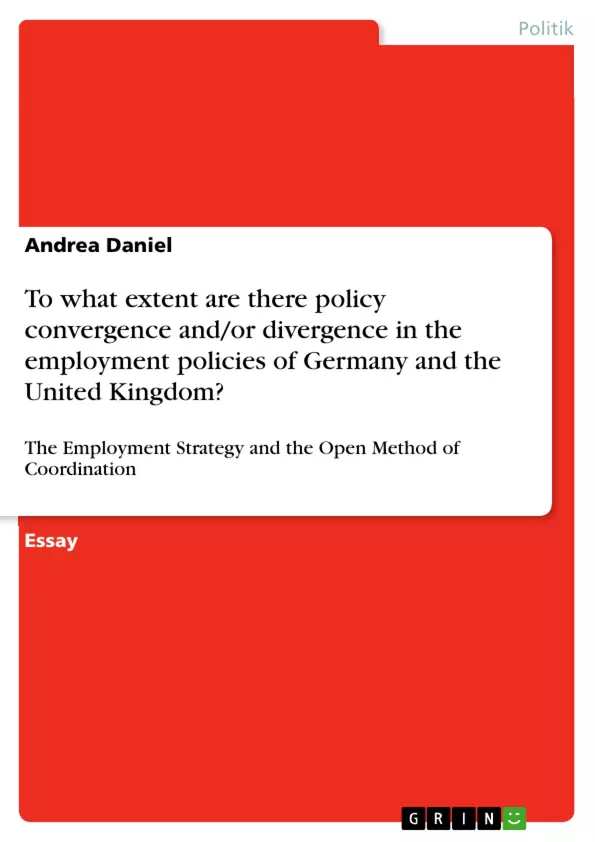After investigating the active employment measures of the United Kingdom and Germany as well as their reforms of the Employment Services since the creation of the European Employment Strategy in
1997, it can be said that Germany adapted huge parts of the British system. The British set the European Employment Strategy’s agenda and extended their policy model to the European level. Via the European Employment Strategy, the British system significantly changed the German one from a highly protective to a liberal model. The German state transferred the responsibility for protection from employment related “common risks of life” to the citizens, reducing its own measures to supporting services and a mere “guarantee of survival”.
Although this convergence of Employment Policy was caused by the European Employment Strategy, it did not contribute to the merging of a unified European Employment Policy or to a public awareness of the European Union’s role in this policy area. While Germany obviously respected the European Employment Strategy as a “superior guidance” and treated it as a self standing “European Policy”, the British used it to extend the reach of their national policies. A real integration of national policies into
an EU-policy did not happen. In the United Kingdom as well as in Germany, the reforms of the employment policies have not been determined and implemented in a process of broad public participation but mostly as a “top-down” process, with decisions made by a professional elite. The European Employment Strategy with its set of policy methods (Open Methods of Cooperation) had
not been able to reach its goals of a more democratic policy making and more public awareness of an independent role of the European Union in employment policy.
Inhaltsverzeichnis
- Abstract
- Introduction
- The subject
- The methodology
- The debate on EES
- The Employment Policy Reforms in the United Kingdom and in Germany
- Public and Private PES
- Linking AEM and unemployment benefit schemes
- Convergence and integrative effectiveness
- Conclusion
- Index of tables
Zielsetzung und Themenschwerpunkte
Die Arbeit untersucht die Konvergenz der Beschäftigungspolitik in Deutschland und Großbritannien im Kontext der Europäischen Beschäftigungsstrategie (EES) und der offenen Methode der Koordinierung (OMC). Sie analysiert, inwieweit die deutschen Beschäftigungspolitiken durch die britischen beeinflusst wurden und ob dies zu einer einheitlichen europäischen Beschäftigungspolitik geführt hat.
- Analyse der Konvergenz der Beschäftigungspolitik in Deutschland und Großbritannien
- Bewertung des Einflusses der EES auf die deutsche Beschäftigungspolitik
- Untersuchung der Rolle der OMC bei der Gestaltung der europäischen Beschäftigungspolitik
- Bewertung der Auswirkungen der Beschäftigungsreformen auf die Arbeitsmärkte in Deutschland und Großbritannien
- Diskussion der Herausforderungen und Chancen einer europäischen Beschäftigungspolitik
Zusammenfassung der Kapitel
Die Arbeit beginnt mit einer Einführung in das Thema und der Methodik. Sie beleuchtet die Entstehung der EES und die Rolle der OMC bei der Gestaltung der europäischen Beschäftigungspolitik. Anschließend werden die Beschäftigungsreformen in Deutschland und Großbritannien im Detail analysiert, wobei ein besonderer Fokus auf die aktiven Arbeitsmarktmaßnahmen (AEM) und die Arbeitsvermittlungsdienste (PES) gelegt wird. Die Arbeit untersucht die Konvergenz der deutschen und britischen Beschäftigungspolitik und bewertet den Einfluss der EES auf die deutsche Politik. Abschließend werden die Ergebnisse zusammengefasst und die Herausforderungen und Chancen einer europäischen Beschäftigungspolitik diskutiert.
Schlüsselwörter
Die Schlüsselwörter und Schwerpunktthemen des Textes umfassen die Europäische Beschäftigungsstrategie (EES), die offene Methode der Koordinierung (OMC), die Konvergenz der Beschäftigungspolitik, die aktiven Arbeitsmarktmaßnahmen (AEM), die Arbeitsvermittlungsdienste (PES), die Beschäftigungsreformen in Deutschland und Großbritannien, die Herausforderungen und Chancen einer europäischen Beschäftigungspolitik.
- Quote paper
- Andrea Daniel (Author), 2009, To what extent are there policy convergence and/or divergence in the employment policies of Germany and the United Kingdom?, Munich, GRIN Verlag, https://www.grin.com/document/126131



